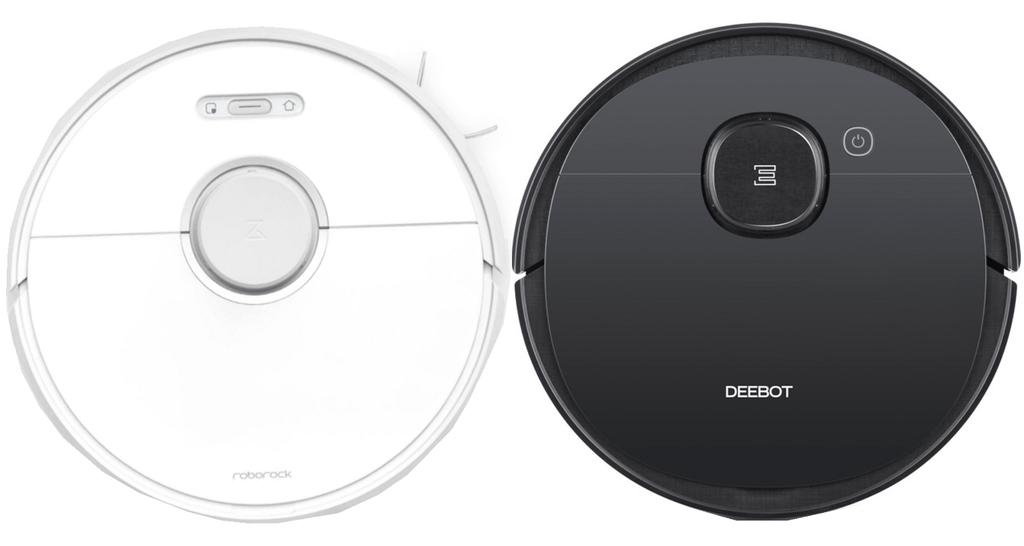In the past, the idea of a robot that could sweep, vacuum and mop was novel, sought-after, but never quite worked. The problem is that an all-in-one robot tends to focus on one aspect more than the other. The ones that mopped well, didn’t vacuum good, and vice-versa.
Two companies have set out to change that, and we compare them here today. The Roborock S6, following a line of confusing namesakes and problematic features, attempts to out-dual the Ecovacs Deebot Ozmo 950. Who gets the nod? In short, The Deebot 950 is the better option. Read on to find out why.
Contents
Differences between Roborock S6 and Deebot Ozmo 950
On paper, both of these robots appear similar. There are a few key differences, though, which I point out below.
[easyazon_image align=”center” height=”500″ identifier=”B07RLRWWPJ” locale=”US” src=”https://smartrobotichome.com/wp-content/uploads/2020/05/515Qbui2NL.jpg” tag=”srh-easyazon-20″ width=”500″]- Even with the same size battery, the S6 can run up to 50 minutes longer than the 950.
- Suction power. Rated in pascals (pa), the Roborock vacuum creates more power (2000pa) over the Deebot 950 (1500pa).
- Noise levels. The Deebot Ozmo 950 is marketed as being quiet (66dB) which it is. However the Roborock is even quieter (50dB).
- Side Brushes. The Roborock uses the more conventional single side brush to get along edges and in corners. The Deebot model has two side brushes at its disposal.
- The Deebot is warrantied for 12 months from date of purchase. This is only half as long as the 2-year warranty from Roborock.
Similarities the Roborock and the Deebot Ozmo
All of the other aspects between the two robots are similar. However, there are some similar features and options I would like to point out.
- Recharge and Resume. Both models will automatically stop to recharge their batteries and then resume cleaning after a charging session.
- Wireless communications. You can use voice commands and mobile apps to take control of the Deebot 950 or the Roborock S6.
- HEPA filtration. Both of these robots use high-efficiency HEPA filters to help keep allergens at bay.
- Scheduling and programming. You can create and edit cleaning schedules as well as program cleaning modes and times with both models.
- Navigation and mapping. The two robot cleaners use laser-guided navigation and mapping methods to create precision layout maps of your floors.
- Mopping abilities. Both the S6 and the 950 use water reservoirs to give you a true wet mop on hard flooring.
- Virtual Containment. You will be able to utilize the mobile apps to create containment barriers on the map that the robots follow while cleaning.
Comparison Table
Now we can see which features and options the two robots offer you in a side by side comparison of their abilities.
| Roborock S6 | Ecovacs Deebot Ozmo 950 | |
| Dimensions | 13.7×13.8×3.8 inches | 13.7×13.7×3.6 inches |
| Weight | 7.7 pounds | 6.6 pounds |
| Battery | 5200mAh lithium-ion | 5200mAH lithium-ion |
| Runtime | Up to 250 minutes | Up to 200 minutes |
| Charge Time | 5 hours | 5 hours |
| Automatic Recharge | Yes | Yes |
| Automatic Resume | Yes | Yes |
| Filter | E-11 HEPA, washable | High-efficiency |
| Motor Suction | Up to 2000pa | Up to 1500pa |
| Scheduling | Yes | Yes |
| Spot Cleaning | Yes | Yes |
| Real Time Location and Programming | Yes | Yes |
| Wireless Communications | Yes | Yes |
| Local Controls | Yes | Yes |
| Mobile App | Yes | Yes |
| Voice Commands | Yes | Yes |
| Navigation | Multi-Sensor Multi-Room | Smart Navi 3.0 |
| Mapping | LDS | LDS |
| Collection Bin Capacity | 0.5L | 0.43L |
| Water Reservoir Capacity | 0.15L | 0.2L |
| Noise Level | 50dB | 66dB |
| Adjustable Water Level | Yes | Yes |
| Select Room Navigation | Yes | Yes |
| Select Room Scheduling | Yes | No |
| Multiple Maps Stored | Yes (3 maps) | Yes (3 maps) |
| Containment | Yes (app only) | Yes (app only) |
| Side Brush | 1 | 2 |
| Floor Types | All | All |
| Damp Mop | Yes | Yes |
| Wet Mop | Yes | Yes |
| Warranty | 2 years | 1 year |
| Price | Check on Amazon | Check on Amazon |
Comparing the Roborock S6 Vs. Deebot Ozmo 950
Now the fun part. I get to tear these two robots apart and find out what makes them work. I will show you how they clean in real-word conditions, as opposed to some lab-test quality pre-measured results you are used to seeing in the commercials and online videos. Let’s get started!
Hard flooring is (almost) every robot’s sweet spot. Hard floors are easier to clean than carpeting because they are flat and don’t require agitation. However, edges and corners pose a problem, especially with pet fur, as that seems to be where it all ends up.
We all know that the Roborock and Deebot mop hard flooring. Further below I will detail the mopping abilities. For now, let’s focus on sweeping and vacuuming.
In the middle of the floor, both robots are about equal. Since the suction power doesn’t matter as much on a solid surface, you won’t see much difference in the pickup ability of these two cleaners.
However, what is important to note here is that the Roborock S6 uses a combination brush roller with semi-stiff bristles. On a small percentage of floors (generally sealed surfaces) the bristles can leave small scratches. For most of you this isn’t a worry, but it needs to be noted. Check in a small area first, if you think it may affect you.
Getting Into Corners
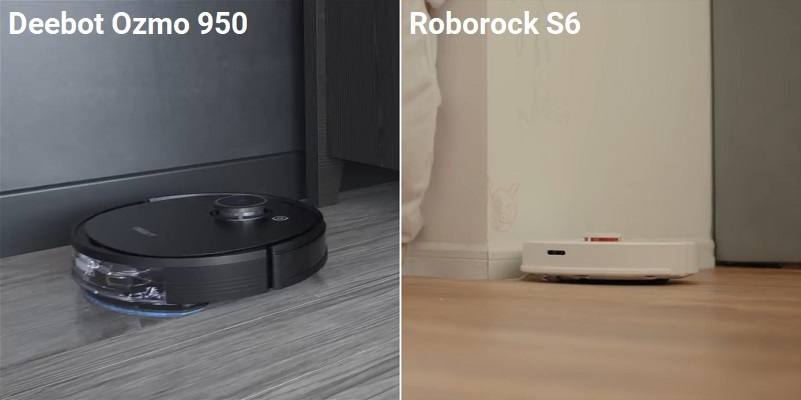
Neither robot is exceptional in the corner cleaning area. Both will do their best, of course and you will see the robots banging around in the corners. However, they both rely more on the side brush abilities than the approach.
The Roborock S6 will approach most corners straight on and then turn along the side brush side. The side brush extends past the frame of the robot, of course, but not far enough to really get deep into right-angled areas. You will be able to tell the corners were swept, but debris will remain.
The Deebot 950 has a similar approach, but doesn’t go out of its way to get into corners. The human-like cleaning patterns will draw the robot to the corners during the course of its cleaning session. With dual side brushes, the robot can turn either way, so it doesn’t matter if it needs to go left or right. As it turns, the side brushes will reach into the corners and gather what they can.
When it comes to the corners of your hard flooring areas, larger debris is collected by both models, though the Deebot 950 is a little more thorough.
Running Along the Edges
When the robots run along the edges of your kitchen and bathrooms, they will encounter a lot of debris. Luck and physics tell us that all our dropped food bits and things from the counters will end up along the baseboards.
Roborock does a decent job along the baseboards, but the robot moves a little fast in this area. The side brush does its best to pick up all the debris here while the robot scoots along. Some will be missed. However, if you run the robot every day, the missed areas from the previous day are collected on the next.
The Deebot 950 is a little better along the edges. It moves a little slower and the side brushes don’t spin as fast as that of the Roborock model. Of course, it isn’t perfect either. Some debris will be pushed away instead of collected, resulting in small piles of dirt and dust that will have to wait until the next cleaning session to get picked up.
Bottom Line: Hard flooring is where both robots excel in their abilities. However, neither one is special in this regard. The Deebot 950 wins because it does clean the hard-to-reach spots a little better.
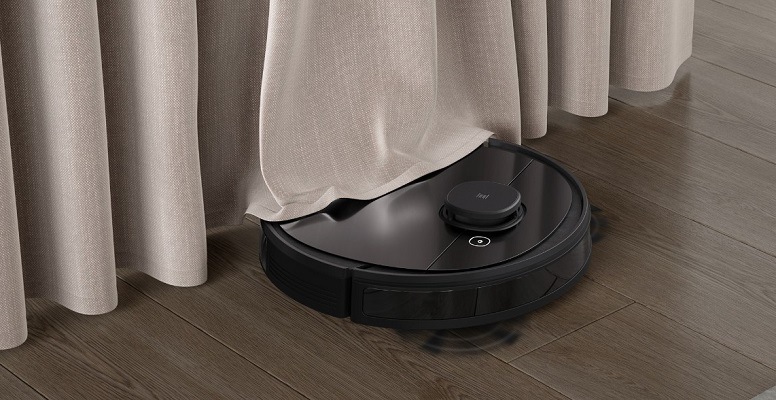
Vacuums need to be able to clean carpeting. While this essential fact seems to need no mention, it does require some discussion. One thing robots have never been able to do (with the exception of maybe the Roomba s9+) is to replace your upright vacuum. Instead, robots are used to maintain floor appearances between regular cleaning.
Dealing with Throw Rugs and Area Rugs
Neither robot produces enough suction to suck up or get caught on larger area rugs. Smaller rugs or bathroom mats, though, may get dragged around a bit. The weight of the rug will determine if it is moved or cleaned, though in most cases, the S6 and 950 will just clean the rugs without issue.
Fringe and tassels on area rugs are going to be a concern, though. If your carpets have fringe you will need to tuck the fringe underneath before the robots get there. The two models will try to collect the fringe like it is debris and then get tangled. In most cases, the Deebot will notice the tangle quickly and shut down to prevent damage.
The Roborock, though, isn’t as quick to shut down and tassels or fringe can cause a lot of problems. This is the same situation when it comes to thin mats or those light, woven rugs used on hard flooring areas.
Low, Medium and High-Pile Carpeting
Now we move on to the carpet that really matters. The first thing you will notice is that neither robot is exceptionally speedy when cleaning carpet. Normally, this isn’t a problem and you want your robots to go a little slower.
The Roborock S6 uses up to 2000pa of suction to clean your carpets and this alone can take on any type of carpet with a lot of success. However, the brush roller is a problem. On low pile carpet, the robot works as expected, agitating the fibers and lifting the loosened debris for collection.
On medium-pile carpeting, the problems start to materialize. The carpet itself gets tangled in the bristles and if not for the high-speed of the rollers, it would probably get stuck. It does clean medium-pile carpeting though, but not as well as you would want from a robot vacuum in this price range. High-pile carpet is nothing but problems, and should be avoided at all costs.
The Ecovacs model is a little better here. The low and medium-pile carpet cleaning shows real results and is quite reliable, as long as you don’t expect cleaning down to the pad like you get with your upright.
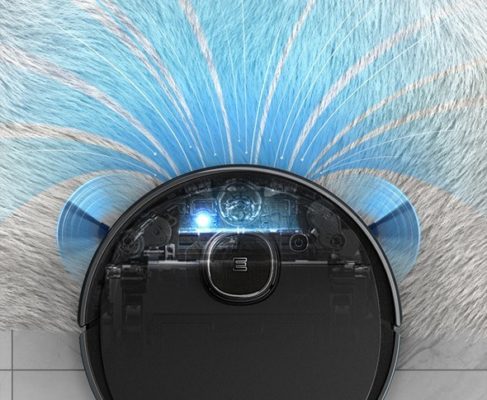
On high-pile carpet, the 950 tries, but will ultimately fail. The same problems with the brush roller come into play. The difference is that the Deebot has carpet recognition that forces the suction power to ramp up when carpet instead of hard flooring is detected underneath.
Don’t expect too much, though, the Deebot 950 only produces 1500pa of suction in what Ecovacs calls Max+ mode.
Bottom Line: Deebot Ozmo 950 has a slight advantage on carpeting over the Roborock S6. Even with the higher suction power, Roborock doesn’t clean deep enough to be elite.
Roborock S6 Vs. Deebot 950 on Mopping
Mopping isn’t a common feature found on robotic vacuums. Both the Roborock S6 and the Deebot Ozmo 950 are models with mopping capabilities. Unlike some other brands, these are true wet mop robots, complete with microfiber cleaning cloths and water reservoirs.
Using the Roborock S6 Mop
Roborock S6 uses a 0.15L water tank. The robot’s manual suggests that you clean the floor in sweeping and vacuum mode at least three times before letting the mopping pad clean the hard surfaces. However, if you are short on time, the Roborock S6 model can sweep and mop at the same time.
The water flow can be adjusted (low or high) to either damp the pad for a longer lasting mop, or a soaking of the pad for a deeper mopping cycle. Your selections aren’t going to matter much, though, to be honest.
Roborock’s mopping feature leaves a lot to be desired. The robot moves extremely slow when mopping. The time it takes the robot to get your floor wet and drag the cloth over the floor could be better used with a stick mop or a Swiffer-style manual mopping pad. The clean would be better, too.
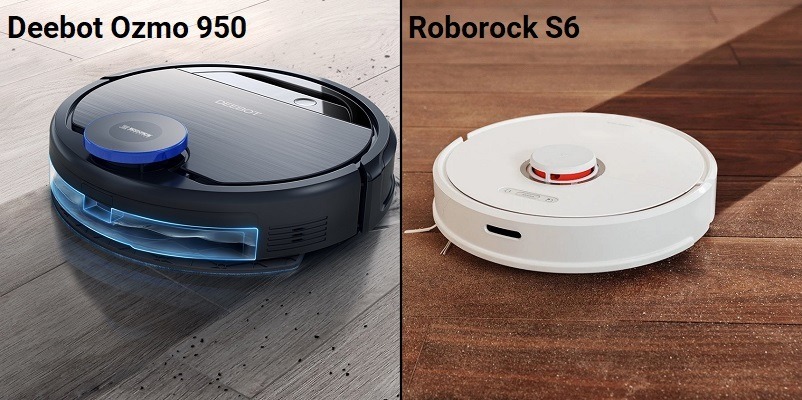
Using the Deebot Ozmo 950 Mop
Like the Roborock, the Deebot vacuums and mops simultaneously. Unlike the S6, though, you don’t need to vacuum three times before you mop. If you are going to mop large areas, it is recommended that you do at least one run through with the vacuum first.
One thing that the Deebot has over the Roborock is that it will not attempt to clean the carpet while it is mopping. With the S6 you need to set up containment walls (covered below) to block off your carpeted areas. The 950, though, detects carpets and avoids them while mopping without the need for containment options.
The results, though, are the same. A lack-luster mopping job by an otherwise decent robot cleaner. For above average mopping you will need to invest in a dedicated mopping robot, like the Braava M6. It will cost you more, but the cleaning will be much better and you will be more satisfied on all fronts.
Bottom Line: The two robots have some flaws in their mopping abilities, much like most all-in-one models. The Deebot Ozmo 950 is a little better at mopping, though, so it gets the win here.
Comparing the Control Options
Both the S6 and the 950 have three control options. The main functionality will come form the mobile app for both models. However, you can also use voice commands and local controls for either one as well.
Local Controls and Voice Controls are Lacking
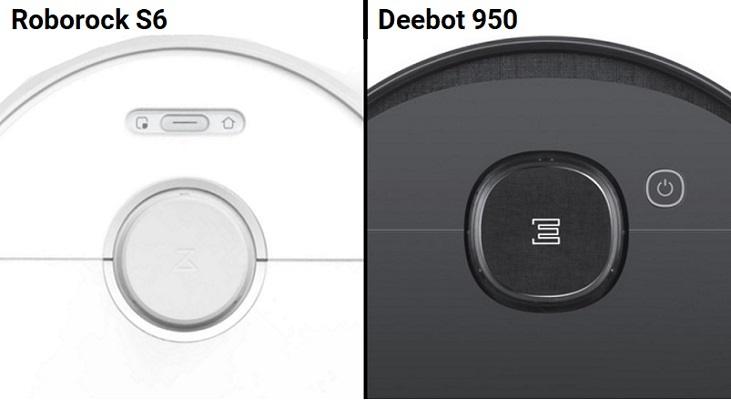
Both robots have limited local controls. This is becoming more and more dominant in the industry as mobile apps are taking the brunt of control duties. With the Roborock S6 you can choose to send the robot out to clean in standard operation, or stop the cleaning cycle and send the robot to the charging station. Both buttons are on top of the robot near the front for easy access.
The Deebot 950 has even less options. There is only one button on top of the robot and when pressed it will start a cleaning cycle. You are expected to be able to press the button a second time to pause the cycle and a third time to send the robot home. However, a lot of reports come in that this doesn’t always work as expected.
For voice commands, both robots are also behind the curve. The Deebot Ozmo 950 has three commands that you can use with Amazon Alexa or Google Assistant. You can start cleaning, stop cleaning or recharge. The good news is that the commands actually work and the robot follows instructions.
The Roborock S6 only has two commands. You can start a cleaning or stop a cleaning. The stop cleaning command, when used with Alexa, will stop the cleaning and send the robot back to the charging station. On Google Assistant, you need the third command (not available with Alexa), to send the robot home.
The Mobile Apps Try Really Hard
It is hard to give a lot of compliments to any robotic vacuum mobile app after viewing and using the iRobot and Neato versions. While these two are easily the best in the industry, Roborock and Ecovacs do try really hard. Roborock has had to separate from Xiaomi, but have been able to take giant leaps after doing so. Deebot is making strides as well.
The confusion following Roborock since their first Mi robot release continues with the S6 series. This time, with the mobile app. When the S6 was released, Roborock also debuted the Roborock App. Much more intuitive than the previous Xiaomi app (which did more than robots). The New app controls all S-series robots (4, 5, 5 Max, and 6). Make sure you download the right one.
The app takes full control of the robot. Allowing you to select rooms, times, create and edit schedules and select cleaning modes. All of Roborock’s containment options (see next section) are contained in the mobile app. You will get battery, filter and cleaning progress reports right in the app. It takes some time to get the hang of using the app, as it is a little unfriendly to new users.
The Ecovacs app is also a fully controlled option. It doesn’t have the confusion that Roborock does, either. You can create and edit schedules, get status reports, see the created map and follow along with the robot if you like. You will see the amount of time the robot has run and a lot of other report-style features.
The containment options work decent enough as well (again, see below for more on containment). The app is more user-friendly than Roborock’s, but it can still become quite cumbersome for first-time users.
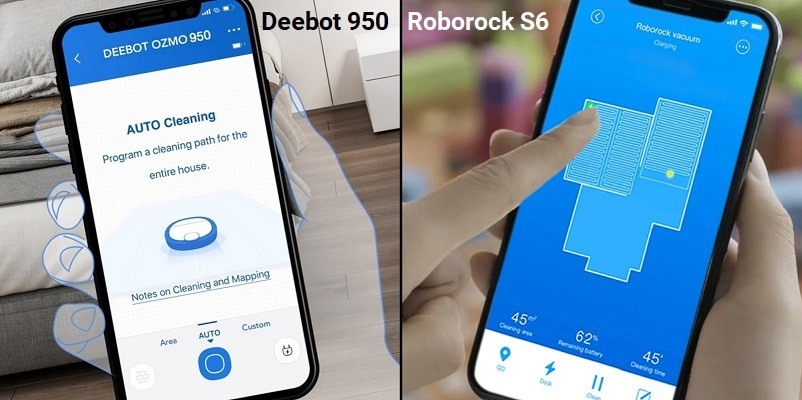
Bottom Line: This is a tie. Both robots use similar apps with the same functionalities. You will need to get used to using each of them, and they both should come with a manual of their own.
Containment Recap
Gone are the days of using physical barriers to contain your robots. Now everything is handled right in the mobile apps. Roborock and Deebot are not the first to do this, and there are still hurdles to overcome for these two models to be top-tier in containment.
Roborock S6 Has a Slight Advantage
I will admit that Roborock has the leg up here, when things work right. First you can use No-Go lines (They now call them Drop Invisible Walls) to block sections of rooms, draw squares on the map for the robot to avoid, etc. However, the S6 is known to often ignore these lines and boxes, going where it wants anyway. Neato had the same problem in the beginning. I am confident Roborock will get this sorted eventually, too.
Where it does shine, though, is in the room selection and time selection modes. Once the map is created, you can label the rooms of your home on the map. Further, you can select an individual room to have cleaned. You can choose multiple rooms as well, or the entire home.
In one nice advancement, not only can you select various rooms of your home, but you can create a schedule for each room on an individual basis. This means you can have the S6 clean the kids’ room while they are at school, the living room just after dinner and the kitchen before you go to bed.
Ecovacs Has an Answer, Though
The Deebot 950 isn’t without it’s form of digital containment. The good news is that for carpeting, this is automatic when mopping and doesn’t need to be set up. However, you will need to define some carpet areas, which can be a real pain to do on the app. Finding the specific area on the map and trying to draw a precision box around it proves quite difficult.
The zone areas can be used to contain the robot inside or outside the box you draw, though, which comes in handy. You can also use multiple zoned areas in the same room. This means you can protect your potted plants, pet food dishes and the coffee table at the same time.
There are less reports of the Deebot ignoring instructions, but there are still a scattered few. You will have to do some trial and error to find out if your robot will mind what you tell it or not. For this reason it is recommended that you test it a few times while you are home before letting it go without you being present to correct any errors.
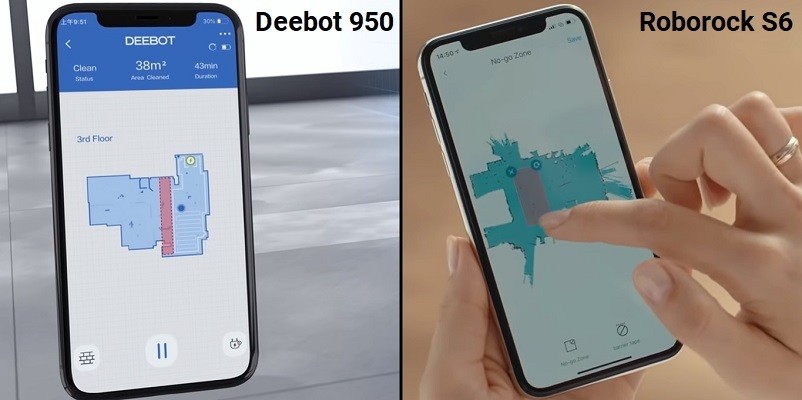
Bottom Line: This ends up being a tie. While the Roborock has a few extra features in its containment, the troubles some of the portions have knocked it down a bit. The Deebot 950 containment works, though it has fewer options.
Frequently Asked Questions
Now I will answer a few of the more common questions about the Roborock S6 and the Deebot Ozmo 950. If you have other questions or concerns, please use the comment section below the article.
Q. Do the filters on the Roborock S6 and Deebot 950 capture allergens?
A. Yes. Both robots have HEPA rated filters. The Deebot uses a high-efficiency disposable filter that will reduce in-home allergens by up to 99%. The Roborock S6 filter is an E-11 HEPa filter that is washable. It isn’t a permanent filter, but will last about 9 months with regular use.
Q. Do I need WiFi to use the robots?
A. No. Both models have local control options so you can have them clean without the use of the mobile app. However, for certain features to work (or for containment) you will need to use the wireless communications and mobile app.
Q. Will these robots empty their collection bins themselves?
A. No. Currently there are only 3 robot vacuums that are self-empty, the Roomba i7+, Roomba s9+ and the Shark IQ SE. The Roborock S6 and Deebot 950 have moderate sized collection bins, but you will need to empty them yourself.
Q. Can I control the noise level of these robots?
A. The Ecovacs 950 robot doesn’t have a silent running mode. The highest decibel rating of the robot is 66dB, which is quieter than a lot of robots on the market. The Roborock S6 runs an average 67dB, however, you can enable silent mode which will run at half speed (producing less suction) but produces only 50dB of noise, which is quiet enough to run while you are sleeping.
Q. Do the warranties cover everything?
A. Both robots have warranties that cover defects, craftsmanship, the motor, sensors and batteries. Roborock’s warranty is 24 months from date of purchase, while the Deebot warranty is 12 months long. Neither warranty covers neglect, damage from shipping or replaceable parts (filters, rollers, side brushes, etc.).
What I Like About the Roborock S6
- Will recharge to 80% before resuming if there is still work to be done.
- Mobile app is getting better with each update.
- Long runtime dwarfs most other robots.
What I Like About the Deebot Ozmo 950
- Avoids carpeting on its own when in mopping mode.
- Digital containment works out of the box.
- Thorough cleaning on more surface types over the Roborock S6.
Conclusion
If you are looking for a mid-tier robot that can vacuum your carpet sweep your hard floor and mop as it goes along, the Roborock S6 and Deebot 950 are solid choices. While the mopping and vacuuming robots leave a lot to be desired, these two do it better than most.
The Roborock S6 has all the features you could want in an all-in-one robot. The main problem is that it doesn’t clean anything in an exceptional manner. If they concentrated on only one aspect, it could be the best robot to date.
As it stands, the Deebot Ozmo 950 wins on vacuuming ability, mopping prowess and overall functionality. For these reasons, it is my pick for the best of this comparison. Either way you go, as long as you don’t expect a clean like the Roomba s9 models, you won’t be disappointed.
